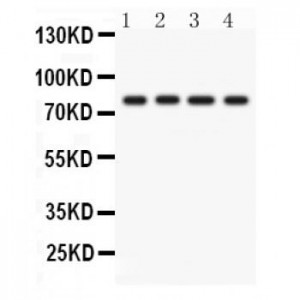More info
Overview
Long Name | Antibody Type | Antibody Isotype | Host | Species Reactivity | Validated Applications | Purification |
| protein kinase C, eta | Polyclonal | IgG | Rabbit | Human | WB | Immunogen affinity purified. |
Immunogen | ||||||
| E.coli-derived human PKC eta recombinant protein (Position: R30-D389). Human PKC eta shares 96.7% and 96.1% amino acid (aa) sequence identity with mouse and rat PKC eta, respectively. | ||||||
Properties
Form | Lyophilized |
Size | 100 µg/vial |
Contents | Antibody is lyophilized with 5 mg BSA, 0.9 mg NaCl, 0.2 mg Na2HPO4, 0.05 mg NaN3. *carrier free antibody available upon request. |
Concentration | Reconstitute with 0.2 mL sterile dH2O (500 µg/ml final concentration). |
Storage | At -20 °C for 12 months, as supplied. Store reconstituted antibody at 2-8 °C for one month. For long-term storage, aliquot and store at -20 °C. Avoid repeated freezing and thawing. |
Additional Information Regarding the Antigen
Gene | PRKCH |
Protein | Protein kinase C eta type |
Uniprot ID | P24723 |
Function | Calcium-independent, phospholipid- and diacylglycerol (DAG)-dependent serine/threonine-protein kinase that is involved in the regulation of cell differentiation in keratinocytes and pre-B cell receptor, mediates regulation of epithelial tight junction integrity and foam cell formation, and is required for glioblastoma proliferation and apoptosis prevention in MCF-7 cells. In keratinocytes, binds and activates the tyrosine kinase FYN, which in turn blocks epidermal growth factor receptor (EGFR) signaling and leads to keratinocyte growth arrest and differentiation. Associates with the cyclin CCNE1-CDK2-CDKN1B complex and inhibits CDK2 kinase activity, leading to RB1 dephosphorylation and thereby G1 arrest in keratinocytes. In association with RALA activates actin depolymerization, which is necessary for keratinocyte differentiation. In the pre-B cell receptor signaling, functions downstream of BLNK by up-regulating IRF4, which in turn activates L chain gene rearrangement. Regulates epithelial tight junctions (TJs) by phosphorylating occludin (OCLN) on threonine residues, which is necessary for the assembly and maintenance of TJs. In association with PLD2 and via TLR4 signaling, is involved in lipopolysaccharide (LPS)-induced RGS2 down-regulation and foam cell formation. Upon PMA stimulation, mediates glioblastoma cell proliferation by activating the mTOR pathway, the PI3K/AKT pathway and the ERK1- dependent phosphorylation of ELK1. Involved in the protection of glioblastoma cells from irradiation-induced apoptosis by preventing caspase-9 activation. In camptothecin-treated MCF-7 cells, regulates NF-kappa-B upstream signaling by activating IKBKB, and confers protection against DNA damage-induced apoptosis. Promotes oncogenic functions of ATF2 in the nucleus while blocking its apoptotic function at mitochondria. Phosphorylates ATF2 which promotes its nuclear retention and transcriptional activity and negatively regulates its mitochondrial localization. |
Tissue Specificity | Most abundant in lung, less in heart and skin. |
Sub-cellular localization | Cytoplasm . |
Sequence Similarities | Belongs to the protein kinase superfamily. AGC Ser/Thr protein kinase family. PKC subfamily. |
Aliases | KPCL_HUMAN antibody|MGC 5363 antibody|MGC26269 antibody|MGC5363 antibody|nPKC eta antibody| nPKC-eta antibody|PKC h antibody|PKC L antibody| PKC-L antibody|PKCh antibody|PKCL antibody| Prkch antibody|PRKCL antibody| Protein kinase C eta antibody|Protein kinase C eta type antibody |
Application Details
| Application | Concentration* | Species | Validated Using** |
| Western blot | 0.1-0.5μg/ml | Human | AssaySolutio's ECL kit |
AssaySolution recommends Rabbit Chemiluminescent WB Detection Kit (AKIT001B) for Western blot. *Blocking peptide can be purchased at $65. Contact us for more information

Anti- PKC eta antibody, ASA-B1532, Western blotting
All lanes: Anti PKC eta (ASA-B1532) at 0.5ug/ml
Lane 1: A431 Whole Cell Lysate at 40ug
Lane 2: A549 Whole Cell Lysate at 40ug
Lane 3: HELA Whole Cell Lysate at 40ug
Lane 4: SKOV Whole Cell Lysate at 40ug
Predicted bind size: 78KD
Observed bind size: 78KD
All lanes: Anti PKC eta (ASA-B1532) at 0.5ug/ml
Lane 1: A431 Whole Cell Lysate at 40ug
Lane 2: A549 Whole Cell Lysate at 40ug
Lane 3: HELA Whole Cell Lysate at 40ug
Lane 4: SKOV Whole Cell Lysate at 40ug
Predicted bind size: 78KD
Observed bind size: 78KD



